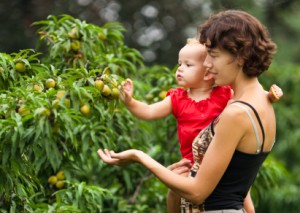 Many gardeners also have family dogs, and most dogs want to be with us no matter where we go. By planning ahead, you can help make your garden more accessible to your four-footed family members, which will allow them to follow you anywhere on your property, even the garden. Below are some ideas that you can incorporate into your garden plot that will help make the family pooch a much more welcome visitor!
Many gardeners also have family dogs, and most dogs want to be with us no matter where we go. By planning ahead, you can help make your garden more accessible to your four-footed family members, which will allow them to follow you anywhere on your property, even the garden. Below are some ideas that you can incorporate into your garden plot that will help make the family pooch a much more welcome visitor!
Elements of a Dog-Friendly Garden
- Gentle hardscape: Making a dry creek bed from smooth flagstones set in a base of pebbles will make a comfortable pathway for both dogs and people to walk on.
- Comfortable Mulch: Cedar chips, small enough to be easy on the feet yet large enough not to cling to silky coats, will add protection to your tender plants and a nice place for Fido to lay on the ground and rest.
- Border Control: Placing pieces of driftwood or decorative limbs around your beds will encourage your dogs to stay away from your garden beds
- Sensible Plants: Plants near walkways and paths need to have soft leaves and flowers but be sturdy enough to stand up to a dog’s roughhousing.
- Marking Post: A large, beautifully shaped piece of driftwood can give your male dogs a place to mark their territory. It can also add a bit of God’s artwork to your garden.
What your Dogs need:
Using the elements that we learned above, we can incorporate many of the things that our dogs need in their garden (for a garden belongs to the whole family).
· Paths to Patrol and Places to Run
Our four-footed friends need exercise just as much as we do. They also feel it is their duty to patrol the boundaries of your yard and to keep away intruders. So giving up a few feet around your garden’s perimeter will allow them the area they need to exercise and will satisfy their need to patrol at the same time. If your dogs have already formed paths around your garden, don’t try to redirect them, just use the ‘gentle hardscape’ idea to make it a proper path. For most dogs, a pathway three feet wide is plenty wide enough. If you would feel better hiding their runway from view, you can plant a screen in front of it. Then they will have their own “secret garden!” If you have the world’s greatest escape artist living in your household, you may want to install an underground barrier to keep your Houdini from digging under your fences. This barrier can be made from rebar, chicken wire, or poured concrete.
· The Right Place for Answering Nature’s Call
Our dogs all need a place to relieve themselves, but is doesn’t have to be in our garden beds or on the lawn. Choose a corner of your yard, mark it off as their restroom, and train your dogs to use this area and nowhere else. This learning process may take a puppy three to four weeks and an adult dog longer still. If necessary, consult a dog-training manual for help.
Choose something easy to keep clean and that your dogs will accept to cover this area. Pea gravel, flagstone, and cedar chips are all good choices. If you have male dogs, you may want to put their marking posts back in this area, too.
· Shelter and Shade
Dogs, like humans, enjoy laying in the sunshine and soaking up the rays. So letting them lay on your patio or lawn for sunbathing is a good idea. But dogs can get over heated, just like people. So it is equally important to make sure there is plenty of shade to provide them a cool spot for respite from the sun. Arbors can serve dual purposes: they can provide a support for your grapes as well as a sweet-smelling shady spot for you and your dogs. But you may also want to give them a place of their own, such as a doghouse.
· Safety
You will want to protect yourself and your pets by making sure that your garden is not a health threat. Make sure that you plant only non-toxic plants in your garden. You can visit https://www.aspca.org/toxicplants [1] to find out what plants are poisonous to pets. Many wild mushrooms are also poisonous if eaten by dogs or humans. If mushrooms appear in your garden, dig them up and dispose of them immediately. Safety is also a good reason to make your compost pile off limits to your dogs. Weeds can be very dangerous, especially foxtail grasses [grasses with barbed seed heads]. Dogs can accidentally inhale them with devastating effects. They can also get into your dog’s ears and cause infections, or even puncture the eardrum.
These tips can be used in your vegetable and flower gardens, or in any areas that you may want to landscape, so that your entire family can be anywhere you are.